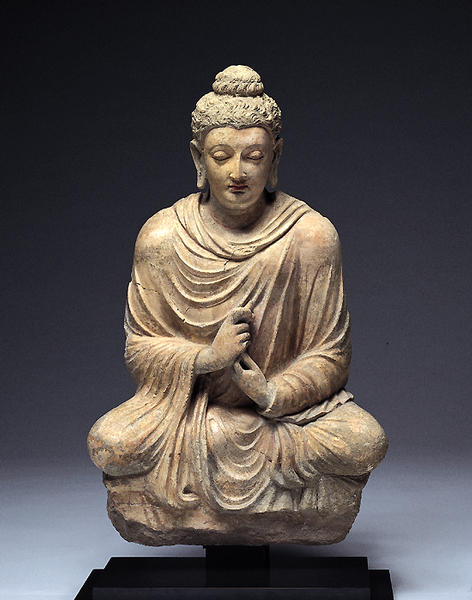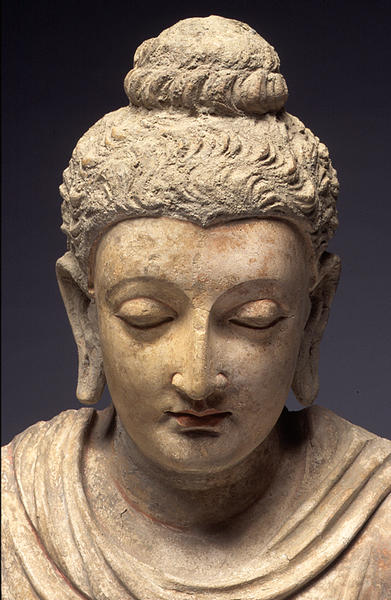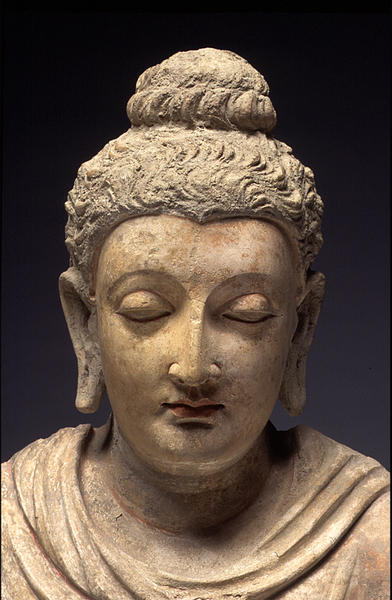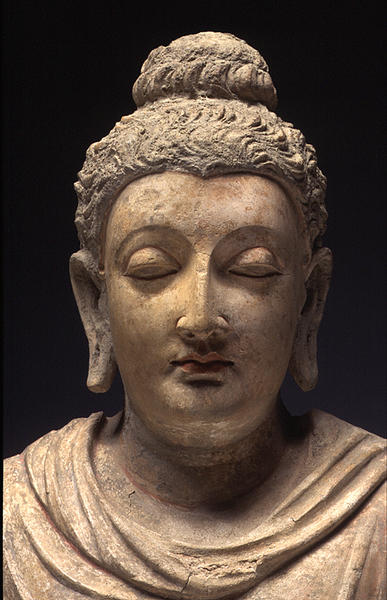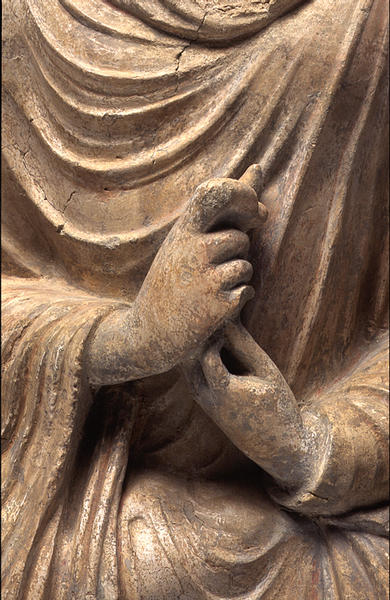転法輪印仏坐像
- ハッダ/タキシラ
- 4-5世紀
- ストゥッコに着色
- H-78
ガンダーラ美術の後期に栄えたストウッコ(塑造彫刻)の典型的な例であるこの作品は結跏趺坐し、両手の親指と人差し指の先端を合わせて輪を作り、他の指を軽く曲げて甲を見せ、右手を上に左手を下にして腹前に構えている。この印相は転法輪印と呼ばれ説法を意味し、座像のみに限られる。波打つような長髪を頭上で束ねて肉けいとし、まとった大衣の深く浅く様々に刻まれた点は、とても自然な表現になっている。頭髪や衣の部分に比べて面相部の土は粒子が柔らかく、上質の白土で仕上げられている。白ごうは刻まず、朱線の小さな円で示され、瞳にも淡い墨の彩色がしてある。その他にも随所に朱が残っているが、この彩色が当初のものかは確認できない。部分的に頭髪には灰色、衣は淡緑色を帯びている事も分かる。
Catalogue Entry
This is a typical example of the molded stucco works that were popular during the late period of Gandharan art. The Buddha is seated and his hands are held in front of his lower torso with the thumbs and index fingers of both hands touching to form wheels, the other fingers lightly curled but leaving the palms showing, and the right hand placed above the left. This is called the gesture of turning the wheel (of the Law), or dharmachakra mudra, and represents the Buddha preaching. This mudra appears only on seated images. The figure's wavy long hair has been bound up on top of the head to form an ushnisha, and a variety of deep and shallow folds appear on the robe, which drapes across both shoulders. These elements are all based on the forms of stone sculptures from Gandhara. A comparison, however, with the standing stone Buddha image also in the Shumei collection (cat. no. 72) shows that the present image is clearly more naturalistic than its stone counterpart. Here, the balanced, intellectual facial features give a sense of a calm, lofty spirituality. The clay used for the face area is finer grained than that used on the head and robes, and it is apparent that the face was finished with a high-grade white clay. The urna is not modeled, but rather a cinnabar red circle has been drawn on the forehead; light black pigment can be discerned on the pupils of the eyes. In addition, green pigment remains on the ushnisha and on top of the eye sockets, while cinnabar remains on the hairlines, the upper edge of the eye-socket, the eyelids, the wings of the nose, the groove beneath the nose, the lips and the chin just beneath them, the neck lines, the lower edge of the neck band, and in various places on the drapery. It is not clear, however, whether this polychrome is original. One can also see traces of grey color in various areas of the hair and light green in the robe.
A large number of stucco sculptures has been excavated from Taxila to the east of Gandhara and from Hadda to the west, in present-day Afghanistan. The oldest stucco sculptures from the region are those excavated from the site of Sirkap in Taxila. Sirkap was constructed by Indo-Greeks at the beginning of the second century B.C. and was the capital of the region until the latter part of the first century A.D. These early works excavated in the area show a striking influence from Hellenistic art, and no Buddhist sculpture have been excavated. Schist was the primary sculptural medium in the region during the Kushan period (first-third century A.D.), and stucco came into wide use in the fourth and fifth centuries.*1 TK
1 For the most detailed reference for stuccos from Taxila and Hadda, Marshall 1951, Barthoux 1930.
